

Common Mistakes in Peer to Peer Coaching. Peer to peer coaching is a development concept that is increasing in popularity.

It holds the premise that people can achieve their personal and professional goals by working with peers. One of its biggest benefits is that it allows a person to talk to someone who can relate to them. It allows them to be their most genuine self without the pressure of having to put their best foot forward with their coach. While this kind of coaching has its benefits, there are a couple of mistakes that participants might commit. Coaching Direct Reports? Work on the Relationship - Center for Creative Leadership. When managers coach direct reports, organizations benefit.
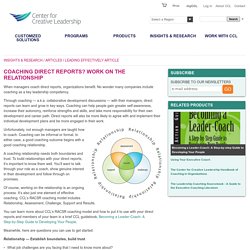
No wonder many companies include coaching as a key leadership competency. Through coaching — a.k.a. collaborative development discussions — with their managers, direct reports can learn and grow in key ways. Coaching can help people gain greater self-awareness, increase their autonomy, reinforce strengths and skills, and take more responsibility for their own development and career path. Direct reports will also be more likely to agree with and implement their individual development plans and be more engaged in their work. Unfortunately, not enough managers are taught how to coach. A coaching relationship needs both boundaries and trust. Of course, working on the relationship is an ongoing process. If You're Not Helping People Develop, You're Not Management Material - Monique Valcour. By Monique Valcour | 10:00 AM January 23, 2014 Skilled managers have never been more critical to the success of firms than they are today.

Not because employees can’t function without direction, but because managers play a vital role in talent management. Gone are the comprehensive career management systems and expectations of long-term employment that once functioned as the glue in the employer-employee contract. In their place, the manager-employee dyad is the new building block of learning and development in firms. Good managers attract candidates, drive performance, engagement and retention, and play a key role in maximizing employees’ contribution to the firm. Giving Every Employee Personal Attention.
By Susan David | 9:00 AM June 10, 2014 Several years ago, a large, global company asked me to help improve their employee engagement.
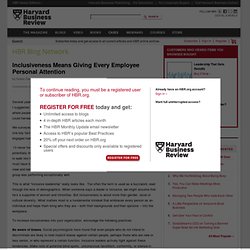
I suggested a strengths-based approach to the problem: a search for “hot spots” in the organization where people were highly engaged and performing well. By understanding what was working, we could harness and replicate these factors across the greater organization. We surveyed thousands of employees from all over the world. Our findings were fascinating, but one key factor emerged: from the Netherlands to India to the United States, those who were most engaged had bosses who gave them personalized attention. Develop the Leaders You've Been Overlooking - Jack Zenger , and Joseph Folkman. By Jack Zenger and Joseph Folkman | 12:00 PM February 13, 2014 Say the word leader and most people immediately think of those with business cards that says “manager,” “director,” or other such lofty title.
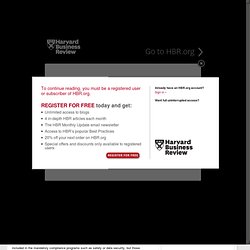
That is, the people who hold positions of stature within a company’s hierarchy, to whom several individuals report, and whose influence comes in great measure from the positions they hold. What is a “High Potential”? Organizations will often use labels to such as ‘rising stars”, “fast trackers”, or “high flyers” to classify employees who are seen as promotable to the next one or two levels, or the having the capacity to grow significantly – above and beyond their current role.
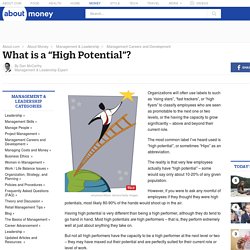
The most common label I’ve heard used is “high potential”, or sometimes “Hipo” as an abbreviation. The reality is that very few employees actually have “high potential” – some would say only about 10-20% of any given population. Five ways to identify future leaders. We’re all leaders in some form.

Whether by design or default, we use our influence to get others to follow us. That’s pretty well how leadership works – it’s all about influence. Using the art of influence is a skill that can take a lifetime to master. But wouldn’t it be great to be able to spot potential great leaders early on? I suggest you can. High Performance Is Not the Same as High Potential. If your company is like most, you probably identify your next leaders from a pool of your top performers.
They might be salespeople or project managers or skilled developers, but in any event, they've got a reputation for delivering results. Stong performance and the results it carries are all well and good, of course, but it does not necessarily indicate that an employee will make a good leader. And according to research from member-based executive team advisory company CEB, companies are seriously hurting themselves by failing to differentiate between performance and potential.
Defining True Potential. Identifying the Best Talent. Have Allan speak at your offices!...
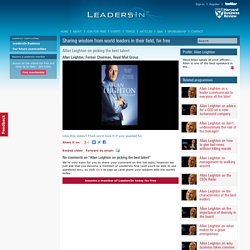
Allan is one of the best speakers in the... Have Allan speak at your offices!... Allan is one of the best speakers in the world. Dreyfuss levels. What to Look for in Potential Leaders. The Performance and Potential Matrix (9 Box Model) – an Update. Note: this is an update to one of the very first posts I wrote in November 2007 and continues to be one of my most popular.
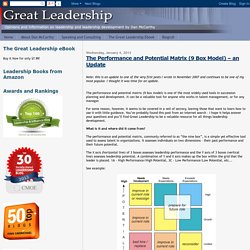
I thought it was time for an update. The performance and potential matrix (9 box model) is one of the most widely used tools in succession planning and development. It can be a valuable tool for anyone who works in talent management, or for any manager. Agility 9 box. Nurturing talent through flexible working arrangements. Ronan Dunne was appointed Chief Executive Officer of Telefónica UK in January 2008.

At this... Ronan Dunne was appointed Chief Executive Officer of Telefónica UK in January 2008. At this time, he also joined the board of Telefónica Europe plc. Ronan Dunne was previously Chief Financial Officer of Telefónica UK, a position held since February 2005. Before this, he held the role of Head of Finance, at parent company O2 plc, reporting to the Group Chief Financial Officer.
Analyzing the Performance System. Providing Developmental Feedback. Coaching an Employee Who Doesn’t Want Help. Becoming a Leader-Coach: A Step-by-step Guide to Developing Your People. A Free Membership That Supports Your Leadership Needs - Join and Save Did you know that you can join the open and always-free myCCL at no cost and get a discount on this CCL Press Publication? CCL provides myCCL members with a 5% discount on CCL Press Publications like this just for being a member. Membership is complimentary in order to support our non-profit goal of connecting a world community of leaders and providing the best in leadership and leadership development for the benefit of societies world-wide.
Mentoring, Coaching or What? The Coaching Mindset - Clip. Top 10 Lists for Great Coaching. Coaching qualities. Effective coach talk: What to say to clients and why it matters. Coaching clients to lasting success depends on saying the right things in the right ways at the right times and really connecting. In this article, we’ll begin to show you how. Have you ever worked with a client with whom you never really connected? Perhaps you played the role of the “typical trainer”: You provided nuggets of information, random statistics and boot-camp-style encouragement. The client played the role of “obedient follower”, with stock responses and hyper-active nods.
GAPS Model.
STRIDE Model of Coaching. Organizations Need Coaching on How to Coach: Report - Latest News. The success of performance coaching hinges on the support of top brass, enabling organizations to generate superior business and employee results, a new study shows. Business results were 21 percent higher among organizations whose senior leaders "very frequently" make an effort to coach others, according to High-Impact Performance Management: Maximizing Performance Coaching, produced by Oakland, California-based advisory firm Bersin & Associates. Additionally, organizations that reported "excellent" cultural support for coaching had 13 percent stronger business results and 39 percent stronger employee results, including engagement, productivity and customer service, the report notes. The report is based on responses from nearly 200 U.S. companies.
It marks the second phase of Bersin's study on performance coaching. "Coaching is the No. 1 performance-management challenge that organizations face, yet most don't understand its value. Asking Questions. Managers Who Coach Ask Questions That Enlighten. Leadership Exec and writer Dan McCarthy prompted today's post. Why Questions Matter. Effective Questions Guidelines. COACHING QUESTIONS & POWERFUL QUESTIONS. Download this page in PDF format. 10 Coaching Questions Managers Use That Work In Any Conversation. 10 Coaching Questions Every Leader Needs to Ask. The best coaches also receive coaching. Company Activities & Management > Sales & Selling from AllBusiness.
Questions That Get Results: Innovative Ideas Managers Can Use to Improve Their Teams' Performance > Questions That Uncover Goals - Pg. 92e. What Great Bosses Know about 7 coaching questions and answers. Most managers I know share similar goals. Active Listening. Seven Keys to Successful Mentoring. This guidebook is available for eBook purchase and download from Apple's iBookstore; Amazon's Kindle; Google eBooks; Sony iStore, and other reputable distributors of eContent. How to Mentor. How do you find the best mentor for you? Mentors have been essential for me. The 9 Keys to a Successful Mentor-Mentee Relationship. 5 Things Socrates Can Teach You About Being a Better Mentor. If you've ever passed through a great books class or Western Civilization 101 while at university, you've probably encountered the Socratic Method.
Mentoring Future Leaders: Setting The Framework For Success Within An Organization! Are you ready to benefit from reverse mentoring? 4 things your boss won't tell you (but a mentor will) LoL Mentors - New User Guide.